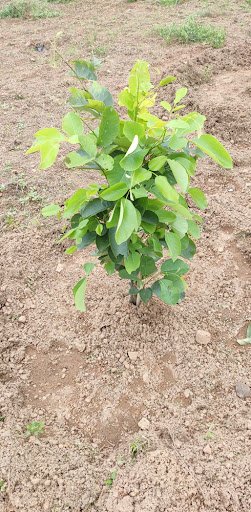The Ultimate Guide to Investing in Red Sandal Farms in Hyderabad

Introduction: Understanding the Potential and Benefits of Investing in Red Sandal Farms in Hyderabad
The city of Hyderabad in India has emerged as a promising hub for investors seeking to capitalize on the potential and benefits of investing in red sandal farms. Red sandalwood, a rare and valuable timber, has seen a surge in demand both domestically and internationally, making it an attractive investment option. Hyderabad’s favorable climate and abundant land resources contribute to its suitability for red sandal farming, with the city already experiencing a substantial number of successful farms. Moreover, the government of Telangana has implemented policies and initiatives to support the growth of this industry, encouraging investors to explore the lucrative opportunities available. By delving into the intricacies of red sandal farming in Hyderabad, this guide will equip potential investors with the necessary knowledge and insights to make informed decisions and maximize their returns.
The Economic and Cultural Significance of Red Sandalwood in Hyderabad
The economic and cultural significance of red sandalwood (Pterocarpus santalinus) in Hyderabad cannot be overstated. Known for its valuable timber, red sandalwood has long been a highly sought-after commodity both nationally and internationally. The wood is in high demand for its use in furniture-making, handicrafts, and even as an ingredient in traditional Ayurvedic medicine. Hyderabad, with its favorable climate and fertile soil, has emerged as a prominent hub for the cultivation of red sandalwood farms. This has not only facilitated economic growth but also preserved the cultural heritage associated with this precious tree. Red sandalwood, known as “Rakta Chandan” in the local language, holds immense religious and spiritual significance in Hyderabad. It is extensively used during religious ceremonies and is believed to possess numerous therapeutic properties. Its cultivation and trade have become a source of pride for the local community and have played a vital role in sustaining the city’s economy. The economic and cultural significance of red sandalwood in Hyderabad makes it an attractive investment opportunity that promises both financial rewards and the preservation of a rich heritage.
The Process and Requirements for Setting Up a Red Sandalwood Farm in Hyderabad
In order to set up a red sandalwood farm in Hyderabad, there are several important processes and requirements that need to be followed. First and foremost, it is essential to identify and acquire the land suitable for cultivating red sandalwood trees. The land should have adequate water resources, proper soil composition, and a suitable climate for the growth of these trees. Additionally, obtaining the necessary permits and licenses from the local authorities is crucial for legally establishing the farm. These permits may include environmental clearances, agricultural licenses, and land conversion certificates. Furthermore, it is vital to have a detailed understanding of the cultivation techniques and practices specific to red sandalwood. This includes knowledge of the ideal planting methods, irrigation systems, and pest control measures. Moreover, investing in high-quality saplings from a reliable nursery plays a significant role in the success of the farm. Finally, setting up a proper infrastructure, including fencing, irrigation systems, and storage facilities, is necessary to ensure the efficient and effective management of the red sandalwood farm in Hyderabad.
Financial Considerations and Return on Investment in Red Sandalwood Farms in Hyderabad
Financial considerations and return on investment play a crucial role in the decision-making process when it comes to investing in red sandalwood farms in Hyderabad. The initial investment required to establish and maintain a red sandalwood farm can be significant, including expenses for land acquisition, infrastructure development, and cultivation activities. However, the long-term potential of this investment is promising due to the high market demand and the commercial value of red sandalwood. The return on investment can be attained through various avenues such as selling mature timber, exporting products to international markets, or engaging in value-added activities like manufacturing furniture or medicinal products. Additionally, the Indian government has implemented a stringent regulatory framework to protect indigenous species, including red sandalwood, which further enhances the investment prospects in this sector. A comprehensive understanding of financial considerations and a strategic approach to investment can lead to substantial returns in red sandalwood farming in Hyderabad.
Regulations, Permits, and Legalities: Navigating the Regulatory Environment for Red Sandalwood Farms in Hyderabad
Regulations, permits, and legalities play a crucial role in navigating the regulatory environment for red sandalwood farms in Hyderabad. As a high-value timber species, red sandalwood has long been subjected to stringent regulations to ensure its sustainable harvest and trade. In India, the cultivation of red sandalwood is regulated under the provisions of the Indian Forest Act of 1927, the Wildlife Protection Act of 1972, and the Biological Diversity Act of 2002. These regulations aim to protect the species from illegal logging and trade, while also promoting its conservation and sustainable utilization. To engage in red sandalwood cultivation, farmers need to obtain appropriate permits and licenses from the forest department, which involve a thorough documentation process and compliance with various guidelines. Additionally, farmers must adhere to specific rules and regulations enforced by local authorities, such as land-use regulations and environmental impact assessments. Navigating this complex regulatory landscape demands meticulous planning, diligent compliance, and a comprehensive understanding of the legal framework governing red sandalwood farming in Hyderabad. By ensuring strict adherence to these regulations, farmers can not only contribute to the conservation of this highly valued species but also secure their investments and pave the way for a sustainable and profitable red sandalwood farming venture.
Managing Risks and Challenges: Climate, Diseases, and Pest Control in Red Sandal Farms
Managing risks and challenges is crucial for the successful operation of red sandal farms in Hyderabad. One major risk that farmers need to consider is the impact of climate change on their crops. Hyderabad is known for its hot and dry climate, but with climate change, there can be unpredictable changes in temperature and rainfall patterns. These changes can directly affect the growth and yield of red sandalwood trees, making it necessary for farmers to adopt adaptive strategies such as introducing irrigation systems and providing shade to mitigate the adverse effects of extreme weather conditions. Additionally, diseases and pests can pose significant threats to red sandal farms. Diseases like stem canker and root rot can lead to a decline in tree health and productivity, while pests like termites and wood borers can cause considerable damage to the wood. Implementing effective disease management practices, such as regular monitoring and timely application of appropriate fungicides, and employing pest control methods like biological control agents and chemical treatments, is essential for preserving the quality and value of the red sandalwood. By recognizing and addressing these risks and challenges, farmers can minimize losses and maximize the profitability of their red sandal farms in Hyderabad.
Optimal Cultivation Techniques for Red Sandalwood in Hyderabad: Soil Preparation, Irrigation, and Propagation
In order to ensure optimal cultivation of red sandalwood in Hyderabad, proper soil preparation is crucial. Red sandalwood requires a well-drained soil with a pH ranging from 5.5 to 7.5. Therefore, the soil should be tested to determine its composition and nutrient levels. If the soil is found to be deficient in certain nutrients, appropriate fertilizers should be added to enhance its fertility. Additionally, the soil should be tilled and cleared of any weeds or debris that may hinder the growth of red sandalwood plants. Furthermore, irrigation plays a significant role in the successful cultivation of red sandalwood. A well-planned irrigation system that provides sufficient supply of water, while avoiding waterlogging, is essential. The frequency and amount of water applied should be adjusted according to the specific needs of red sandalwood at different growth stages. Finally, propagation techniques should be carefully chosen to ensure successful growth and development of red sandalwood plants. Propagation through seeds and cuttings have been found to be effective methods for reproducing red sandalwood. Adequate attention should be given to seed selection, treatment, and sowing practices to promote germination and vigorous seedling establishment. Overall, with proper soil preparation, precise irrigation techniques, and appropriate propagation methods, red sandalwood cultivation in Hyderabad can be optimized for maximum yield and profitability.
Harvesting and Processing Red Sandalwood in Hyderabad: Maximizing Yield and Quality
In conclusion, maximizing yield and quality in the harvesting and processing of red sandalwood in Hyderabad is crucial for successful investment in red sandal farms. By implementing the strategies discussed in this guide, such as careful selection of planting sites, proper spacing, regular pruning, and timely harvesting, investors can ensure optimal growth and yield of red sandalwood trees. Additionally, adopting efficient processing techniques, such as drying, seasoning, and grading, will help maintain the quality of harvested sandalwood logs. It is important to note that investing in red sandal farms requires careful planning, management, and adherence to legal regulations. With the potential for high returns, the cultivation and trade of red sandalwood can be a lucrative venture for those investing in Hyderabad.
Market Demand and Export Opportunities for Red Sandalwood Products from Hyderabad
In conclusion, there is a significant market demand for red sandalwood products both domestically and internationally. The demand for these products stems from their various applications in the pharmaceutical, cosmetics, and furniture industries. With Hyderabad being the hub for red sandalwood cultivation, there are abundant export opportunities for farmers and investors in the region. The high demand for red sandalwood products can be attributed to their unique properties, such as their medicinal value and exquisite aesthetics. Additionally, the increasing awareness of sustainability and environmental conservation has further fueled the demand for red sandalwood, as it is a highly sustainable and renewable resource. Therefore, investing in red sandal farms in Hyderabad not only promises strong returns but also contributes to the global market’s demand for eco-friendly and natural products.
Case Studies and Success Stories: Inspiring Examples of Profitable Red Sandalwood Farming in Hyderabad
Case studies and success stories are a valuable source of inspiration and knowledge for aspiring red sandalwood farmers in Hyderabad. By delving into these examples of profitable farming ventures, individuals can gain insights into the key strategies and practices that have led to success. These case studies highlight the various factors that contribute to profitability, such as careful selection of land, effective irrigation methods, and diligent maintenance and pruning of the sandalwood plants. Additionally, success stories shed light on the importance of proper market research and understanding the demand for red sandalwood products. By studying these case studies and success stories, prospective investors can learn from the experiences of others and increase their chances of establishing and running a profitable red sandalwood farm in Hyderabad.
Conclusion: Unlocking the Potential of Red Sandalwood Investment in Hyderabad.
In conclusion, investing in red sandalwood farms in Hyderabad holds great potential for investors looking to diversify their portfolios and capitalize on the increasing demand for this valuable wood. The favorable climate and soil conditions in Hyderabad, along with the support from the Telangana government, make it an ideal location for red sandalwood cultivation. Additionally, the high market prices and consistent demand for red sandalwood in various industries further highlight the profitability of this investment. By carefully following the guidelines and recommendations outlined in this guide, investors can unlock the full potential of red sandalwood investment in Hyderabad and reap long-term financial benefits.
